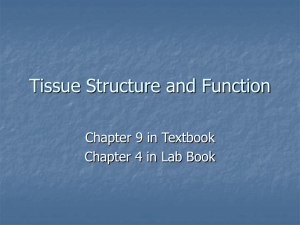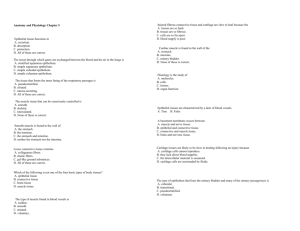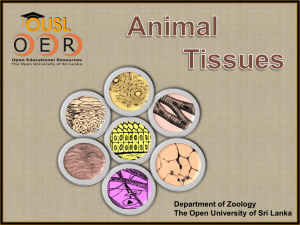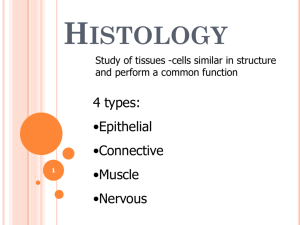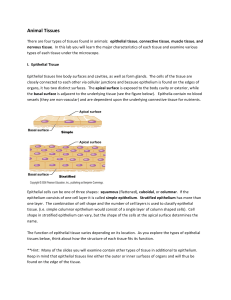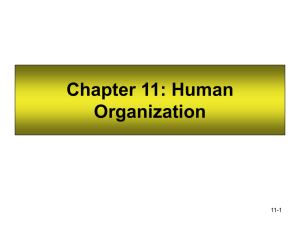click - Uplift Education
advertisement
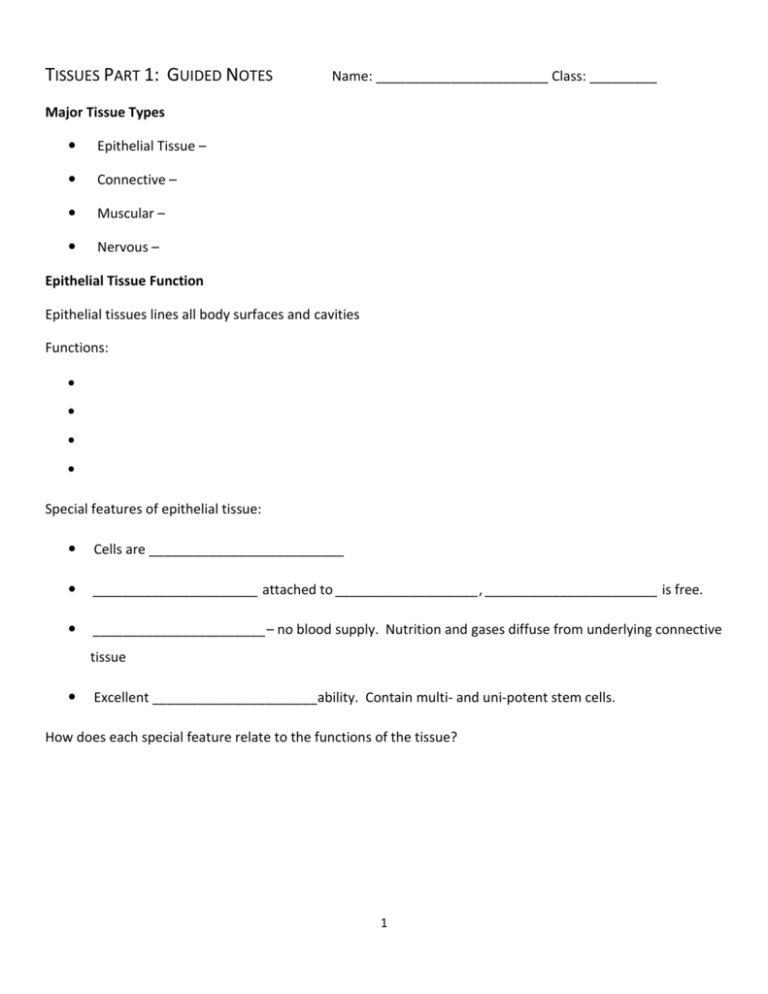
TISSUES PART 1: GUIDED NOTES Name: _______________________ Class: _________ Major Tissue Types Epithelial Tissue – Connective – Muscular – Nervous – Epithelial Tissue Function Epithelial tissues lines all body surfaces and cavities Functions: Special features of epithelial tissue: Cells are __________________________ ______________________ attached to ___________________, _______________________ is free. _______________________– no blood supply. Nutrition and gases diffuse from underlying connective tissue Excellent ______________________ability. Contain multi- and uni-potent stem cells. How does each special feature relate to the functions of the tissue? 1 Classifying Epithelial Tissue Simple squamous epithelium A single layer of ____________cells, specializing in rapid diffusion and filtration Found in: alveoli of lungs, walls of capillaries, kidney glomeruli and serosae 2 Simple cuboidal epithelium A single layer of _______________________ cells Found in: glands, kidney tubules, ovaries Simple columnar epithelium A single layer of _______________ shaped cells Often contain mucus- producing ____________ ____________ and / or cilia Found in: digestive tract (unciliated), bronchi (ciliated), and uterine tubes (ciliated) Pseudostratified columnar epithelium A single layer of cells ______________________ Often contain cilia and Goblet cells Found in: respiratory tract 3 Stratified Squamous Epithelium _____________________of epithelial tissue. Flattened and atrophied (‘dead’) at the apical edge; but can be rounder at basal edge. Apical edge sloughs off and is replaced. Function: protection from wear & tear Found in skin, mouth, esophagus Transitional epithelium Cells can ______________________, allowing the tissue to stretch. Apical cells appear round when tissue is relaxed, and flat with tissue is stretched. Found in urinary tract. Connective Tissues Most abundant type of tissue Functions: 1. 2. 3. All connective tissues are made up of _____________________________________ and _____________________________________. The extracellular matrix is secreted by the cells. 4 The extracellular matrix is composed of ____________________________________ (water, adhesion proteins (‘glue’), polysaccharide molecules). The ground substance can be fluid or firm depending on how many polysaccharides there are. __________________________ the types and amounts vary. ____________________– strongest ____________________ – stretchable ____________________ – netlike & supportive Bone (osseous tissue) Hardest connective tissue ________________________________ found in lacunae Functions: __________________________, ______________________, _________________________ Contain collagen fibers and calcium salts Cartilage Softer & more flexible than bone ____________________________________ found in lacunae 3 types of cartilage, each containing different proportions of the 3 fibers 5 ________________: ends of bones ________________: vertebrae ________________: external ear Dense Connective Tissue Forms tendons, ligaments, and layer beneath skin ____________________________________ between collagen fibers Loose Connective Tissue Areolar Tissue _______________________________ Adipose tissue (________________) Most common connective tissue! _______________________, _______________________, and ______________________________ Consists of ________________ and ________________ (fibroblasts and immune cells) scattered loosely in a fluid containing water, nutrients, salts and waste Very little matrix, mostly _______________________________ Each cell filled with oil Functions: ______________________________, _______________________________ _______________________________ 6 Blood • Consists of cells within a matrix: _______________________. • Like other connective tissues, blood does have fibers, but these are only involved in clotting. • Functions: __________________________, ______________________, and __________________________ throughout the body Connective Tissue Flow Chart Muscular Tissue Function: ________________________________________________ Special Features: 1. Possess ___________________________________ (actin & myosin) which slide past each other to contract the cell 2. _________________________________ (many blood vessels) to supply energy and oxygen Skeletal Muscle _________________________________ of the body Skeletal b/c attached to bones (mostly) ______________________________________ ______________________________________ _______________________________________ Cardiac Muscle Skeletal muscle cells are called muscle fibers 7 Found in heart __________________________________ (have to squeeze) Contain _____________________________ – allow for rapid spread of electrical impulse for coordinated contraction Smooth Muscle Found in walls of hollow organs (_________________________,______________, _______________________, _______________________) Slowly squeezes and relaxes (in all directions) to propel substances through Motion called _________________________ Nervous Tissue Function: ________________________________ ________________________________________ Consists of _____________________ and ___________________________ (that insulate, support and protect neurons) Neurons have long processes to carry impulse to distant areas. 8




